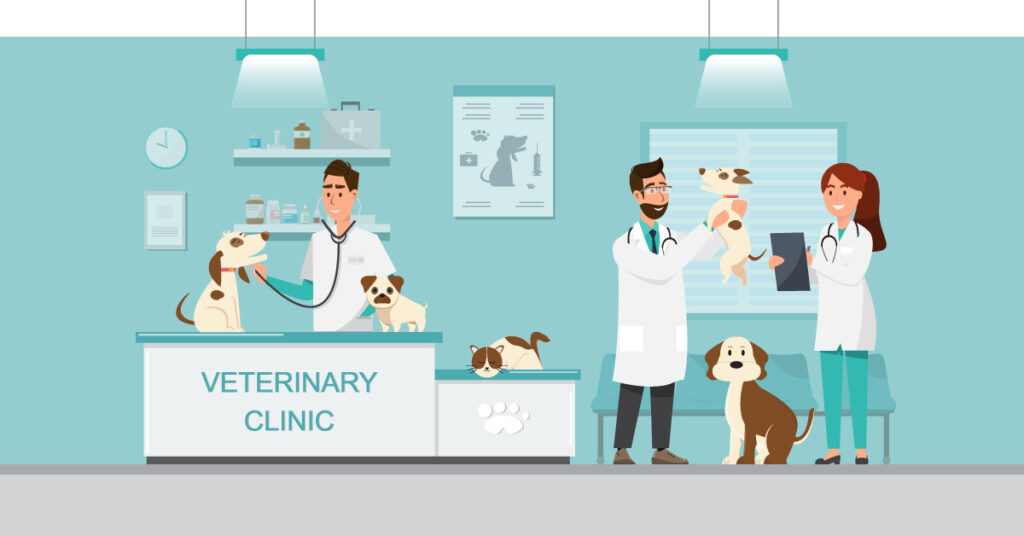Conducting A Daily Huddle In Any Veterinary Practice
This is the fifth in a series of blog posts written by Louise S. Dunn, who’s partnered with VetMatrix to provide educational content for veterinarians in different areas of their practice. Louise has 45+ years of experience in the veterinary field. She’s the owner of Snowgoose Veterinary Management Consulting, author of multiple books including “The 5 Minute Consult,” “Pathways to Ownership,” and “Veterinary Clinics of North America,” she is also a Fear Free certified professional.

It’s first and then – the offense huddles before executing the play. It’s down to a buzzer-beater – the team gathers around the coach for the strategy. Almost every sport has a time when the players gather to get insights for the next play. No long meeting, no sit down for an hour to discuss options, just a quick recap of what has transpired. In comes the game plan of what is needed to score or stop the opponent from advancing. Businesses took notice of the concept and the results – and the ‘huddle’ moved from the playing field to the office.
In the veterinary office, the daily huddle can be one of the best ways to encourage teamwork, provide clarity and reduce chaos. Huddles are brief (10 minutes) standup meetings occurring at the start of each shift. The purpose can vary from veterinary hospital to hospital, but the most common focus is looking ahead at the day’s schedule.
Benefits Of The Huddle
Take a moment and go back to this morning at your vet hospital. Clients are arriving, the phone is ringing, and patients are getting checked in….when the client service representative (CSR) asks if it is ok to squeeze in a sick cat? Those within earshot start grumbling about having no time. Hospitalized patients still need to be looked at, and the kennel attendant called off sick. Suddenly, it’s like the CSR is a clueless bad guy trying to ruin the day. What if the day started with a huddle?
Before the phone calls and check-ins, the team huddles in the treatment area. They are informed about the kennel attendant calling off and who will be filling in. The hospital census is reviewed on the whiteboard, the appointment book is looked at. Then spots to squeeze in a sick pet are identified beforehand. Now, when the CSR answers the phone, they already know the game plan to execute this morning. Prior to the start of the next shift, there is a review of the morning results, a discussion of potential trouble spots, an update on the hospital census, and a new game plan communicated to the team.

Improving Daily Productivity
Huddles can help the team avoid confusion and identify bottlenecks that can wreak havoc on patient care, client service, and team performance.
They can allow the team to raise issues for immediate solutions or escalate issues to a manager or practice owner. In addition, huddles can provide an opportunity to close the loop on prior concerns. As well as give praise to team members, announce new patients or clients coming today.
Plus, update the status of practice goals, or share important notices about changes to policies or procedures during your daily huddle. Save your team time and energy by avoiding poor decisions and the redundancy of tasks. The huddle ensures timely answers and enforces team accountability.
To start doing huddles, know why you want to conduct huddles, set the start time……7:52 AM, 12:48 PM. Your choice, but most experts recommend choosing an odd time because it gets people’s attention. Stick to the time limit such as 5 minutes but no more than 15 minutes), display the agenda (see examples in the next section – but do not make it too long for your time limit), and close on time.
Developing A Huddle Agenda
It’s essential to follow a plan – call it a checklist or an agenda. There is no single agenda that works in every practice – this is where each practice’s strategic imperatives come into play.
The following are examples of huddle agendas:
Example 1:
- Check-in With the team
- Review today’s schedule & identify scheduling opportunities
- Discuss special patient needs for today
- Share practice updates, policy changes
- Share a client compliment or social media testimonials
Example 2:
- What did we do ‘right’ yesterday (or previous shift) – any honorable mentions of team members who went the extra mile?
- Review schedule – potential trouble spots for emergencies
- Identify new clients/new patients – prep welcome kits, prepare for typical questions
- Follow-up calls – update patient status from post-op or post-appointment calls
- Social Media/Testimonial/Reviews – share updates from clients, what the practice is posting
Example 3:
- Victories from yesterday
- Priorities for today
- Anything that has you stuck?
Example 4:
- Are there any unconfirmed appointments?
- Do any clients have outstanding balances?
- Who are the new clients/patients?
- Are there any potential scheduling conflicts today?
Example 5:
- What’s up – what are some accomplishments since the last huddle
- The numbers – critical metrics we are monitoring
- Roadblocks – bottlenecks being experienced
- Our values and ideology
As evident by the examples, the huddle agenda can take many different forms. Tailor your agenda to meet specific areas if the practice is large enough for each area to conduct its own huddle (i.e., CSR, Lab, Surgery, Kennel). The critical factor in creating the huddle agenda is what does the practice want to accomplish?
Measuring The Effectiveness Of The Huddle

To measure your daily huddle’s effectiveness, refer back to what you are trying to accomplish. It may be because you want to improve client service by not having long appointment delays.
Perhaps the goal is to improve patient care by having everyone aware of the hospital census and patients coming in for appointments. Or it’s about building community and team efficiency. Another reason may be to reduce adverse events, improve client satisfaction, or enhance team engagement. Each veterinary practice has its reason – know the ‘why’ and then assess the effectiveness.
One way to assess the effectiveness of the huddle is to debrief at the end of the shift. This is not the time to assign blame, but instead, focus on identifying the pros and cons of actions and decisions. As well as identify important issues that unfolded, and performance gaps needing attention.
A debreifing session will provide information about whether the communication was clear or not. Debriefing should be a quick, five-minute query asking the team what worked well and what did not. This will help determine if the team understood their roles and responsibilities. These efforts help pinpoint when potential situations were successfully mitigated.
Make a note for future reference – after all, you want the team to gain knowledge, comprehend the outcomes, and apply what they learned to future situations.
Other measurements may entail metrics such as appointment fill rates, new clients and new patient numbers, or client satisfaction survey results. There are measures for team efficiency such as revenue per FTE DVM, invoices per FTE DVM. Also staff hours per transaction can also shed light on the change in the team’s performance after starting huddles and debriefings.
Brief huddles enable communication that builds a culture of trust. As a result, the team can maintain awareness of patient scheduling, client needs, business goals, and team performance. Like the sports team, the goal is to ensure a win at the end of the day.
To sum up, have a daily pow wow every day at your veterinary hospital. Create an enjoyable, productive works space, prepared to tackle challenges at ease.



